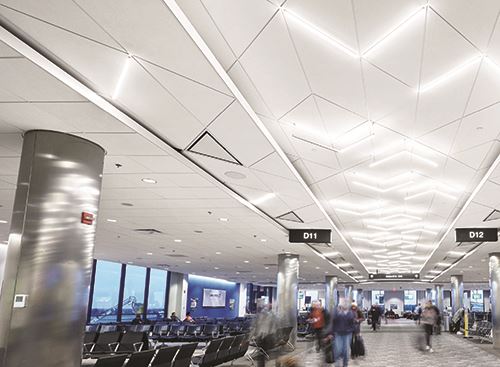Form over function, or function over form? It’s an age-old debate with no definitive answer. Baltimore/Washington International Thurgood Marshall Airport (BWI) and its project partners chose both for the recently completed $20 million renovation of Concourse D.
Form over function, or function over form? It’s an age-old debate with no definitive answer. Baltimore/Washington International Thurgood Marshall Airport (BWI) and its project partners chose both for the recently completed $20 million renovation of Concourse D.
A new geometric ceiling provides the facility with an entirely new look, and systemic improvements were made behind the ceiling and elsewhere to reduce operating and maintenance costs.
Key changes include:
- a full architectural ceiling replacement,
- LED lighting upgrades throughout the concourse,
- new roof-mounted HVAC equipment,
- replacing the building automation system,
- a new 1,500-ton chilled water plant and
- structural systems modifications to support the new HVAC system.
Concourse D, which was originally constructed in the early 1980s, serves two of the airport’s longtime tenants, Delta Air Lines on the X pier and United Airlines on the Y. Although the facility had been well maintained through the years, the HVAC, lighting and architectural finishes had exceeded their useful life, explains Paul Shank, chief engineer at the Maryland Aviation Administration. Shank has the unique perspective of working on the original Concourse D design about 40 years ago and also leading the recently completed modernization.
|
Project: Concourse Renovations Location: Baltimore/Washington Int’l Thurgood Marshall Airport
Airport Owner/Operator: Concourse: D Size: 100,000 sq. ft. Key Elements: Full architectural ceiling replacement; full concourse LED lighting upgrades; systemic HVAC upgrade, including new roof-mounted HVAC equipment, building automation system replacement, new 1,500-ton chilled water plant & structural systems modifications to support the new HVAC Cost: $20 million HVAC & Mechanical, Electrical & Plumbing Design: JMT Ceiling & Lighting Design: JMT Architecture; MCLA Architectural Lighting Design; MAA Architecture
Fire Protection Engineer: Civil Engineer: ADCI Construction Manager: Hill Int’l General Contractor: Towson Mechanical Inc.
Certified Partnering Leadership: Ceiling System: Calla Shapes for DesignFlex, by Armstrong LED Lighting: JLC Tech T-Bar Flex Controls: Johnson Controls Fire Systems: Honeywell
Accolade: Chapter Technology Award from The American Society Key Benefits: Improving passenger experience; reduced maintenance & operating costs |
Improving the passenger experience was the overriding goal of renovations that began in 2019 and ended this June. Enhancing the concourse’s air system was one of the primary strategies. Shank notes that HVAC systems often take a backseat to more glamorous terminal improvements such as concessions, but properly conditioned air is very important to the traveling public. Recent upgrades in Concourse D were engineered to enhance the performance and sustainability of the HVAC system as well as improve indoor air quality and passenger comfort. “If it’s too hot in the building or it smells of Jet-A, you’ve failed,” he remarks.
It was also imperative for the modernization project to reduce annual maintenance and energy costs. That was addressed by replacing existing fluorescent lighting throughout the concourse with LEDs, and installing new HVAC infrastructure, including the chilled water plant that serves the 100,000-square-foot concourse. “Obviously a 40-plus-year-old system was starting to get expensive,” Shank says. The previous HVAC system still functioned, but the BWI team knew that more advanced technology would reduce maintenance and operational costs.
All told, the upgraded HVAC system is expected to save the airport about $120,000 annually. In fact, the project won an award from The American Society of Heating, Refrigeration and Air Conditioning Engineers for its innovative approach to energy efficiency, improved indoor air quality, cost effectiveness and overall environmental impact.
Commitment to Partnership
As with other projects, it was important to complete the concourse renovations within budget and on schedule to maintain commitments to the airlines and tenants. First and foremost, Shank attributes success in those areas to the partnering process BWI uses.
“Not just a handshake and a slap on the back,” as he describes it.
With the help of Ventura Consulting, the airport and its project team operated under a formal partnership to complete the Concourse D project. Paul Crotty, a master level facilitator certified by the International Partnering Institute, led sessions to encourage open discussion about challenges and opportunities and to set ambitious goals.
People and departments impacted by the project were involved in all aspects of planning, he adds. They included the airport fire marshal, maintenance personnel, operations staff, the finance department, TSA, concessionaires, airline partners and design consultants, as well as the airport offices of engineering, construction and architecture. Meetings were held monthly, and other communication was even more frequent to ensure all partners were involved and informed.
Goals weren’t limited to construction milestones. Specific objectives were established for all members of the project team.
Partnering for a Plan
In 2017, JMT developed an initial planning document to address how the needs of the concourse aligned with the available budget for renovations. The primary need was replacing and upgrading the HVAC, but the airport couldn’t delve into those improvements without also impacting the ceiling.
Following the mantra of Maryland Aviation Administration CEO Ricky Smith, the project team asked how the concourse could “be better”—not bleeding edge, but leading edge.
“It has to be functional, not just pretty architecture,” Shank remarks. “It’s hard to pay for just pretty.”

If crews had to tear down the ceiling for HVAC work, the airport didn’t want to just put back up what it previously had. So JMT Architecture and its lighting consultant, MCLA, explored a variety of design options.
Design charrettes using 3-D renderings were conducted to facilitate engagement between JMT’s architectural design studio and BWI’s architecture team. The project team wanted to “create a bright, light, well-designed concourse that livens up the space, and replace old light fixtures with LEDs for energy savings and longevity,” explains Jo Schneider, director of Architecture at the Maryland Aviation Administration.

Jennifer Hensel, a JMT design associate, notes that a stepped ceiling throughout the concourse posed a particular challenge. With heights ranging only between 11 and 8 feet, it would be difficult to make the space feel light, bright and open, while also reserving room for HVAC equipment, fire protection systems, signage and lighting.
 In partnership with BWI architects, the JMT team created a ceiling and lighting solution that immediately resonated with the owner. “We had options, because they had competing designs and working sessions,” recalls Shank. “But the choice was unanimous.”
In partnership with BWI architects, the JMT team created a ceiling and lighting solution that immediately resonated with the owner. “We had options, because they had competing designs and working sessions,” recalls Shank. “But the choice was unanimous.”
JMT chose an Armstrong ceiling system, Calla Shapes for DesignFlex, which allowed designers to mix and match different shapes and sizes to create a unique look. For the main corridor, designers chose 45-degree left parallelograms, 45-degree right parallelograms and 45-degree triangles. Many of the cross members in the suspended ceiling grid system were replaced with JLC Tech T-Bar Flex lights designed to integrate with the specialized ceiling tiles. The project included more than 26,000 square feet of corridor space, which required crews to locate, position and install more than 6,000 brackets and field-connect to nearly 2,000 perimeter connection clips.
Shank notes that the geometric architectural ceiling integrates seamlessly with the HVAC system, including air diffusers coordinated with the DesignFlex geometry, while also creating the feeling of movement and enhancing lighting levels. “It creates a wonderful lighting expression that is almost like arrows pointing you to your destination,” he explains. “It feels like airplanes in flight; it feels like movement.”

The Armstrong system incorporated directly into the grid system of the ceiling lighting, which allowed designers to be creative with the patterns, layout and configuration of the lighting. “We saw that as a significant way to make an impression on the traveling public,” Hensel explains. “It would not only be bright, but it would be different.”
In all, 45,000 square feet of 2-foot square Calla panels were installed in holdrooms to reflect light and brighten up the low-ceilinged areas. They also help improve the acoustics. With low ceiling heights and HVAC equipment filling up the limited ceiling space, designers still wanted to achieve the feeling of high ceilings because they help decrease stress for travelers. “We had limited height to work with,” recalls Hensel. “We had to do it by using design finishes and lighting to create the illusion that you are in a larger space.”
Precision Planning
To minimize the project’s impact on operations and passengers, significant planning went into creating a precise timeline for each phase of the ceiling replacement and installation of HVAC terminal units and rooftop equipment. Most work was scheduled overnight, after flight activity stopped. But that period is only about four hours at BWI. Crews accomplished as much as possible during their small windows of opportunity, and then had to return the space in usable, safe and secure condition by morning. Ensuring safety and security while minimizing noise and dust were paramount, Shank emphasizes.
 With the various aspects of the project so intertwined, collaboration and coordination were critical from design through construction—a dynamic that underscored the importance of the team’s formal partnership agreement. Placement of the ceiling panels around electrical infrastructure, speakers, cameras, fire suppression and signage had to be carefully considered. “It was a lot of visits to check above the ceiling, and a lot of coordination meetings within all disciplines to ensure that there weren’t any conflicts with relocating items,” says George Steinrock, aviation lead with JMT. “To me, that was one of the biggest challenges.”
With the various aspects of the project so intertwined, collaboration and coordination were critical from design through construction—a dynamic that underscored the importance of the team’s formal partnership agreement. Placement of the ceiling panels around electrical infrastructure, speakers, cameras, fire suppression and signage had to be carefully considered. “It was a lot of visits to check above the ceiling, and a lot of coordination meetings within all disciplines to ensure that there weren’t any conflicts with relocating items,” says George Steinrock, aviation lead with JMT. “To me, that was one of the biggest challenges.”
Pre-construction design work and mockups allowed the team to test different lamp temperatures to achieve the best comfort level for individual holdrooms and the concourses, says Steinrock. “The team was out there several nights to fine-tune the desired lamp temperatures and dimming levels of the fixtures,” he recalls. “Quite a bit of work went into getting it right.”
The project required the integration of nearly 850 new light fixtures. Lighting throughout the concourse is wired to dedicated controls so airport personnel can easily adjust lighting levels. For example, as direct sunlight varies throughout the seasons, levels in select areas can be adjusted to compensate, without affecting lights elsewhere. Upgrading from fluorescent to LED lighting was important in terms of energy savings, but also created a brighter, calmer space that met current code requirements, Hensel adds.

Crews were restricted to opening only 2,500 square feet of ceiling at a time because of fire codes, and the team worked with the Fire Marshal’s Office to schedule intermittent shutdowns of the sprinkler system to replace sprinkler heads.
This planning and careful phasing allowed the project to move efficiently, Hensel reports. “The way it was broken down and the percentage the workers could do in each phase, that contributed to the success,” she elaborates. Setting the standard for design and clear expectations for each phase was another key factor, she adds.
Managing the project through a global pandemic proved challenging from a supply chain perspective, Shank adds. “Equipment lead times were a big issue, and they’re still a big issue for other airport projects,” he says. “It’s the biggest problem we have.”
However, that didn’t prevent the Concourse D project from finishing on schedule.


 facts&figures
facts&figures

